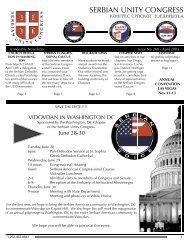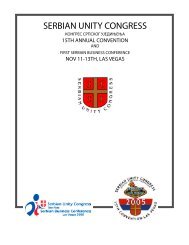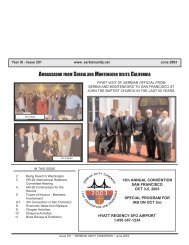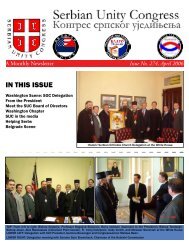BULLETIN - Serbian Unity Congress
BULLETIN - Serbian Unity Congress
BULLETIN - Serbian Unity Congress
You also want an ePaper? Increase the reach of your titles
YUMPU automatically turns print PDFs into web optimized ePapers that Google loves.
TRIP TO KOSOVO AND METOHIJA<br />
diers that the reason more Serbs go to<br />
Turkey on vacation than to Montenegro<br />
is that Serbs and Turks were in a “political<br />
union” for a longer period of time.<br />
The intelligence, subtlety and sophistication<br />
of Bishop Abbot Teodosije and<br />
Father Sava would be rare to find in any<br />
milieu. They speak softly and never in<br />
anger, though sometimes with disappointment.<br />
Their understanding of what<br />
it takes to live well with ones neighbors<br />
and what it takes to survive is both deep<br />
and sensible. They are too far from the<br />
rest of Serbia to expect any protection or<br />
for Serbs to come to the area and work at<br />
the monastery; consequently, they have<br />
to make certain accommodations. They<br />
freely admit that without a continuing international<br />
presence their very survival<br />
would be at stake. Even with the KFOR<br />
presence around the monastery, a few<br />
months ago a rocket propelled grenade<br />
hit a wall near the church.<br />
The monks will not leave their monastery;<br />
after all, they say, St. King Stefan<br />
Uroš Dečanski is not leaving. However,<br />
like the nuns at the Patriarchate of Peć,<br />
they too are building a fortified wall for<br />
protection. When US diplomats tell them<br />
that they should build friendships, not<br />
walls, the Abbot says, first the wall then<br />
they will be free to build friendships. My<br />
colleague Dushan and I told the Abbot<br />
about the Robert Frost poem “Mending<br />
Wall” and its refrain: “Good fences<br />
make good neighbors.”<br />
In many ways the monks are selfsufficient<br />
and grow their own food, make<br />
cheese, have honeybees and a vineyard.<br />
We drank their wines, which could have<br />
a label saying “Established 1310.” But<br />
amid their work and prayers, the monks<br />
carry a general disappointment of the<br />
lack of understanding of their situation<br />
by the outside world and even by their<br />
own government.<br />
Gračanica<br />
Our third stop was Gračanica. On<br />
the way we drove through the village of<br />
Kosovo Polje near the actual place of the<br />
famous battle. The Gazimestan monument<br />
was visible from the road but is<br />
daily getting more crowded by haphazard<br />
real estate development. Everywhere<br />
one drives in Kosovo and Metohija, one<br />
sees a need for urban planning and zoning<br />
regulations.<br />
The monastery in Gračanica is in an<br />
urban setting. A community of about<br />
8,000 Serbs lives precariously in the<br />
area around it. The monastery’s rocky<br />
medieval walls have seemingly random<br />
patches of three bricks placed either<br />
vertically and horizontally. From a<br />
distance the patches are not random,<br />
they occur in regularly spaced intervals<br />
at standing height and kneeling height.<br />
These are old defensive openings for<br />
guns. Today, the guns are carried by UN<br />
troops and by the nearby Albanian Mus-<br />
lims. In addition to the wall, the monastery<br />
is defended by small traffic barriers,<br />
barbed wire and KFOR troops from<br />
Norway.<br />
Gračanica with its current church,<br />
dating from 1321 with its famous fresco<br />
of Queen Simonida with the gouged-out<br />
eyes, has a very different feel from the<br />
other two monastic communities we<br />
visited. [See, www.srpskoblago.org/<br />
Archives/Gracanica] This is the seat of<br />
Bishop Artemije, whose jurisdiction covers<br />
Kosovo and Metohija. The grounds<br />
are tired looking and not as pristine as<br />
those at Peć or Dečani. The small sisterhood<br />
tends a large garden and a recently<br />
planted fruit orchard.<br />
There are many visitors and events<br />
on the enclosed grounds surrounding<br />
the church. This walled refuge is a small<br />
breathing space for the beleaguered<br />
Serbs still left in the area. Yet, normal<br />
urban services such as refuse collection<br />
are random. Electricity brown-outs occur<br />
daily as do water outages. The Albanians<br />
control the water and power, and<br />
say that every one is subject to these<br />
inconveniences. They also claim that<br />
the Serbs do not pay regularly so their<br />
brown-outs and water outages are longer<br />
than those of the surrounding Albanian<br />
community. With so few jobs available<br />
and with the danger of going to and from<br />
work, the Serbs’ livelihood in the area is<br />
bleak. When the Belgrade government<br />
tries to pay for their utilities, the Albanians<br />
and their facilitators do not want<br />
16 www.serbianunity.net<br />
<strong>Serbian</strong> <strong>Unity</strong> <strong>Congress</strong> Newsletter, No. 282, Summer 2007







